1920's Thingamobob on Cooke 2-6-0 Tenders
12



















12
1920's Thingamobob on Cooke 2-6-0 Tenders
|
This post was updated on .
I've been experimenting with HOn3 C&S stuff to see if I can make it operate as smoothly and reliably as my Sn3 models.
My first brass bashing project is a P.S.C. unpainted C&S 7 2-6-0, updated to the locomotive's 1927 appearance. I've been studying various prototype photos of number 7 to see what era specific detailing might be required. Several photos from 1922-1927 show an odd strap metal, vertical appliance attached to the very rear of the tender of number 7: http://digital.denverlibrary.org/cdm/singleitem/collection/p15330coll22/id/42446/rec/77  Arriving Denver, October 1922. I first noticed this "thingamobob" years ago and always assumed it was a support for a signal cord, that ran from the locomotive cab, over the coal load, through the vertical support, then on through the signal cord holes in the ends of each passenger car. But enlarged for study, that doesn't seem to be the case:  The "A" shaped brace appears to be constructed of a single strap of sheet metal, bent into an upside down "U" at the top, the strap then twisted 90 degrees so the flat sides face to the rear. A cross brace of strap stock is bolted horizontally in the middle, forming the cross of the "A". The appliance is placed at the tender tank rear, behind the end grab iron on the tender tank top. No cord is visible to the hole in the following baggage car. There is a metal rod just behind the "A" frame that curves forward at the top, forming a tripod. The rod (if that is what it is) attached to a small cylinder atop the "A" frame; the cylinder is about the size of a soup can. There is no hole for a cord to pass through. A view of number 7 at Silver Plume in 1926 doesn't show the A-frame thingy clearly, but the shadow cast on the end of the combine provides more detail: 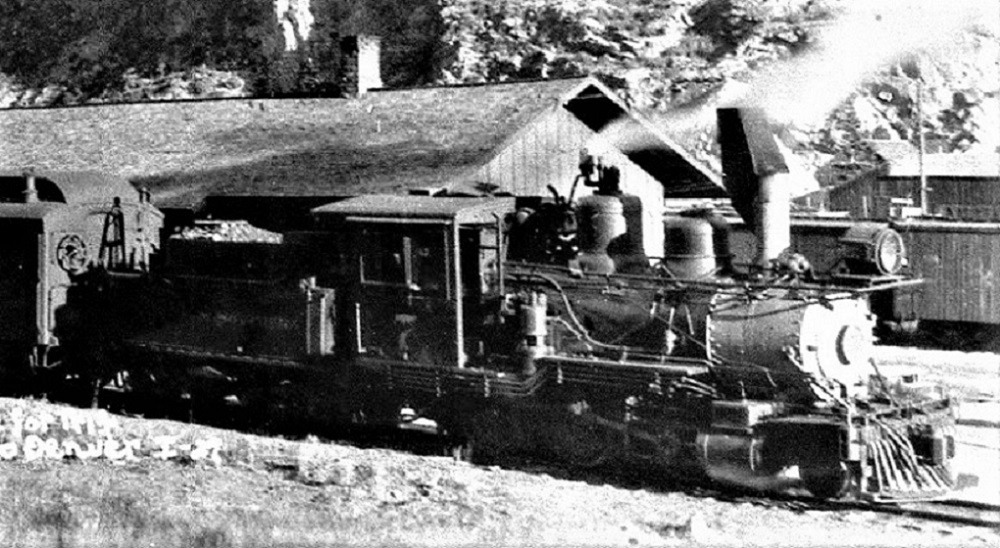 Sanborn photo, Courtney collection. A third vertical strap is attached to the cross of the "A" to the tender tank top. A view of number 7 on the last run from Silver Plume in 1927 adds another piece to the puzzle: http://digital.denverlibrary.org/cdm/singleitem/collection/p15330coll22/id/42450/rec/1 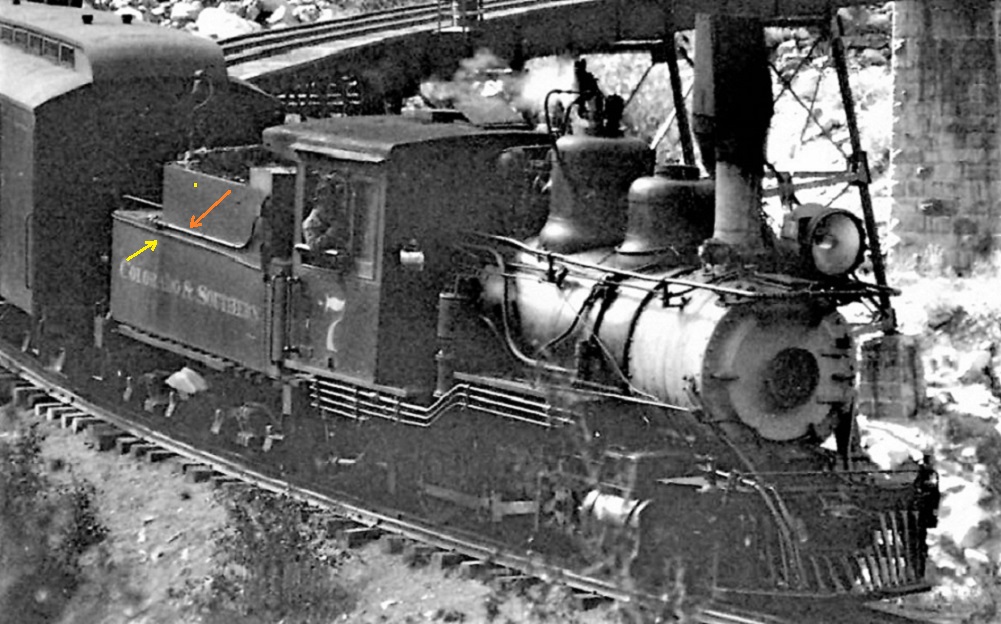 The A-frame thingy is lost in the shadows, but the "tripod" rod now appears all curvy, more like a wire than a vertical structural support. And check out the side of the tender tank. The small diameter pipe runs at the top of the tender tank to the retainer at the front of the tender (yellow arrow). But wrapped around the tender coal board extension is a larger diameter pipe, that runs forward to a joint of some sort (orange arrow). I began to wonder if the third (rod) support was actually an electrical cable or conduit and whether it was continuous with the pipe or conduit on the side of the sheet metal coal side board. The Northern Pacific used a similar arrangement on the engineer's side of the tender to attach a cable from the cab, to conduit running back to power the tender's back-up light . . . So is the A-frame thingy a support for high mounted, soup can sized back-up light??  Was it unique to number 7? Number 7 commonly was assigned to the morning down train from Silver Plume to Denver. The return commonly placed number 7 back in Silver Plume late in the day, after dark in winter months. Was a small backup light needed to switch at Silver Plume in the evening? Standard gauge passenger locomotives often carried a standard headlight forward, with a tiny can type light on tender rear, for backing movements in terminals and round house areas after dark. If this A-shaped thingy was a high mount for a small back-up light on narrow gauge passenger engines, were there other examples?? Well, yes, between 1921 and 1927, several Cooke 2-6-0's sported them; they were gone by 1930. 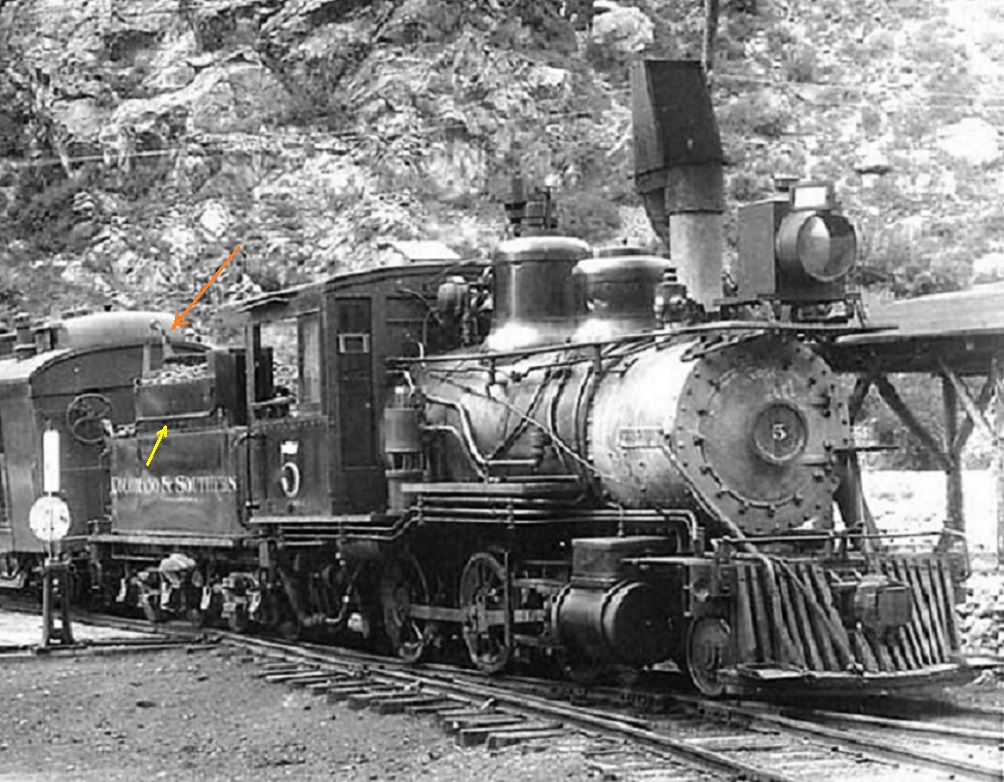 Silver Plume 1926. Ducca photograph, Courtney collection. C&S number 5 has the A-frame appliance (orange arrow) and the extra pipe or conduit on the tender side (yellow). http://digital.denverlibrary.org/cdm/singleitem/collection/p15330coll22/id/42174/rec/67  C&S number 8, even earlier in 1921, sported the appliance (orange arrow). An enlargement gives about the clearest view: 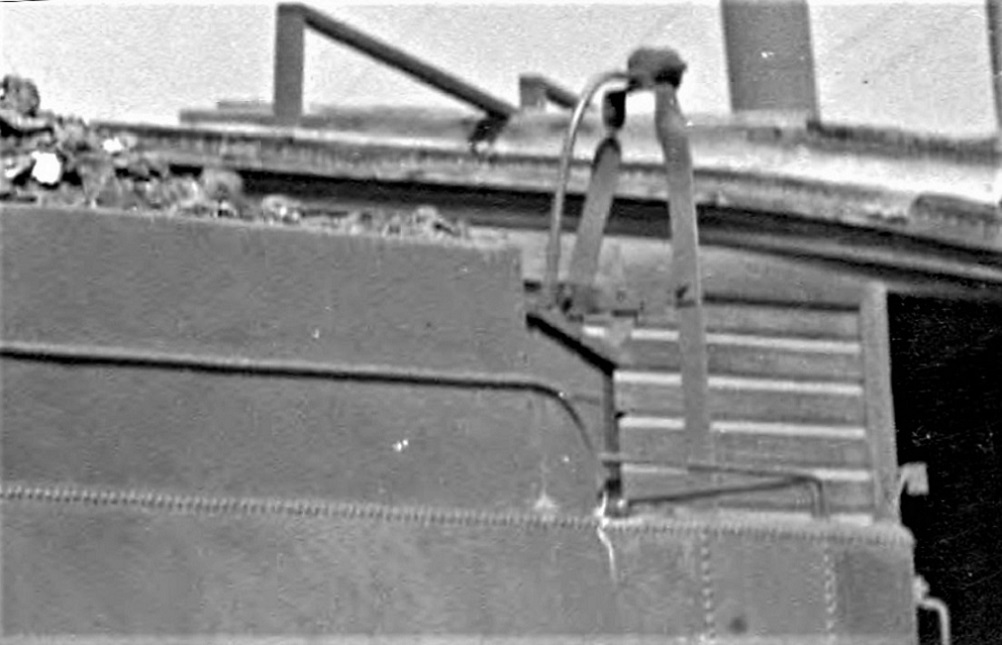 If that is indeed a back-up light, it is tiny! A brakeman with a flashlight (err . . . "torch") sitting on the tender rear, would seem just as effective for backing movements at night. Note again that the metal A-frame appears attached to the far rear of the top of the tender tank, beyond the rear handrail. And C&S 8 still had teh appliance and the engineer's side conduit / pipe in 1926:  Since both C&S 5 and C&S 8 were commonly used on Clear Creek passenger trains, along with C&S number 7, I thought that perhaps this weird A-frame "back-up light" was just a Clear Creek thing. Nope, I've seen photos of both C&S 9 and C&S 10 also sporting this appliance in the early to mid 1920's. Here is C&S number 9 leaving Denver for Como in 1922: http://digital.denverlibrary.org/cdm/singleitem/collection/p15330coll22/id/42471/rec/1  And enlarged: 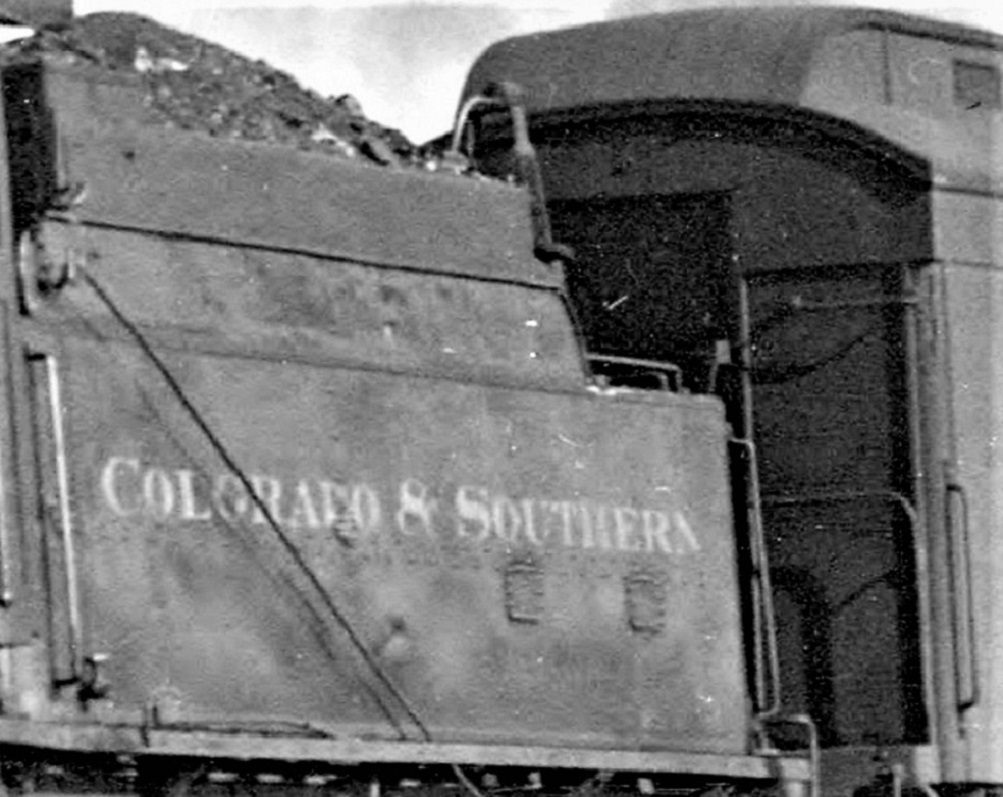 The only C&S big Cooke 2-6-0's without the A-frame appliance (at least in period photos that I have found to date) are numbers 4 and 6 -- both were generally west end Como-Leadville locomotives during this era. I have found no photos of the appliance on the non-rebuilt Cooke 2-6-0's 11-12-13, nor on the rebuilt Brookes 2-6-0's 21 and 22. I have not found a photo showing this appliance on any C&S 2-8-0. And both the appliance and the conduit on the tender side disappear from the 2-6-0's after 1929 or 1930. So, this weird A-frame metal appliance seems to me to be a high mount for a soup can sized back-up light on the Cooke 2-6-0 passenger engines of the 1920's. Anyone have another explanation for these odd devices?? How about any other clear photographs?? And perhaps John Greenly, with his photo analysis skills, can offer me some dimensions for this C&S oddity . . . 
Jim Courtney
Poulsbo, WA |
Re: 1920's ThingamoBob on Cooke 2-6-0 Tenders
|
Early wifi/celfone receiver/router ?
"Duty above all else except Honor"
|
Re: 1920's ThingamoBob on Cooke 2-6-0 Tenders
|
Glad you opined, SP.
Does that look like any kind of headlight from the 1920 era? It looks much smaller than one of the headlamps on your truck. The little soup can could be an electric plug, at the end of the conduit, but for what? None of the C&S narrow gauge passenger cars ever had electric lighting. The little thing doesn't look like it justifies such a large conduit. It's even smaller than the marker lights on the locomotive smoke box. Could this just be an electric rear marker? If so, why? These particular locomotives didn't routinely run light at night, like the 2-8-0 helpers. And if it is a single rear electric "tail light", why so high? Any other ideas of what it might be?
Jim Courtney
Poulsbo, WA |
Re: 1920's ThingamoBob on Cooke 2-6-0 Tenders
|
Administrator
|
Jim, you got me on this. I'm sure I have noticed that bracket in pictures, but I never gave any thought to what it was. As they were not there in the 30's, I just blew it off. I guess....
But I'm sure it was a backup light, as was suggested. I was thinking about this earlier, and remembered that #70 had a backup light, and also one was added to #73 in '38 or '39. My thought would be, following the probable reasoning of the two engines who had them in later years, was that they may have been there for use on the Blackhawk Branch. Does anyone know when passenger and/or mixed service was discontinued to Blackhawk? |
|
Could this be the counter part on the baggage car? To get power to the RPO electric lights? Or steam?
http://digital.denverlibrary.org/cdm/fullbrowser/collection/p15330coll22/id/42472/rv/singleitem/rec/22  Alex |
Re: 1920's ThingamoBob on Cooke 2-6-0 Tenders
|
Jim,
You are correct, that soup can-looking thing is, well ... about the size of a soup can. Much smaller than any sort of headlight sort of light that I can think of in the era. Cowl lights were smaller diameter, even smaller than a soup can, but these were not the type of fixture that projected light forward to light up the area ahead, but rather, to make the vehicle visible to others, like parking lights on a post-war vehicle.
"Duty above all else except Honor"
|
Re: 1920's ThingamoBob on Cooke 2-6-0 Tenders
|
In reply to this post by Mike Trent
Interesting theory, Mike.
There really wasn't a need for backing up between Forks and Blackhawk in the 1920's; engines could be turned on the table at Blackhawk and the wye at Forks. But the switchback from Blackhawk to Central City was another matter. Four round trips a day from Central to Forks to connect with the Denver--Silver Plume trains, half of each trip in reverse on the switchbacks. I usually think of the smaller Cookes 10-11-12 or Brooks 22 as the usual power on these trains, but no doubt the big rebuilt Cookes did make it to Central as well: 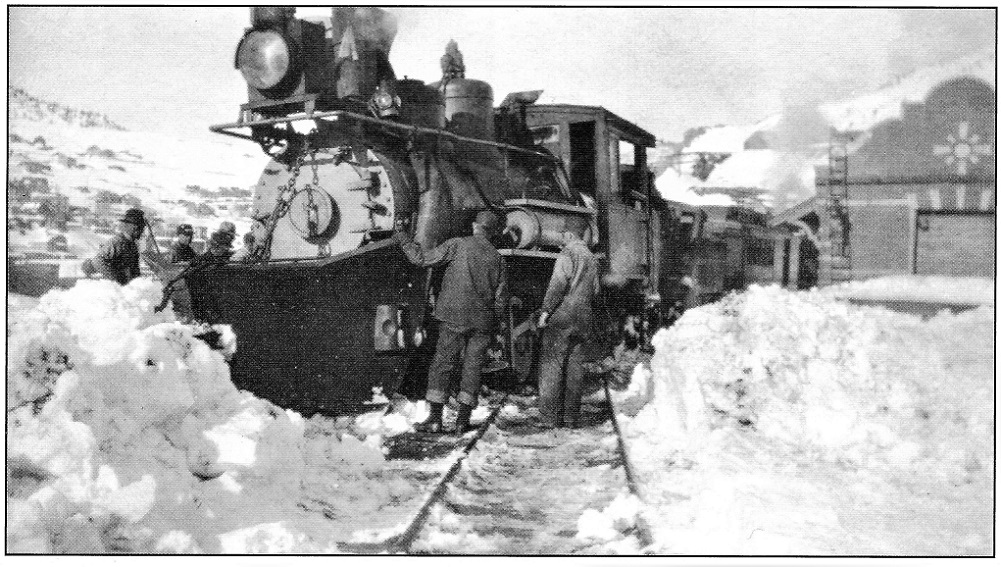 September, 1921. Robert Schoppe Collection, in the Klingers' C&S Clear Creek District Memories. C&S number 8, after arriving at the Central depot, derailed during a freak early autumn snow storm -- according to the dates, this photo was taken within a couple of weeks of the Otto Perry portrait of C&S 8 by the sand house in Denver, at the top of the thread. Although we can't see it, the odd elevated bracket with soup can light must be there. But I cannot imagine that such a back up light, just for this purpose, would be applied to all (or most) of the rebuilt Cooke 2-6-0's. Of the seven rebuilt Cooke locomotives 4-10, I've found photos of this tender contraption on five of them. It is possible that numbers 4 and 6 also carried this feature--I just haven't found photos of these locomotives during this era. Besides, by the early-1920's until abandonment in 1927, the passenger run to Central had devolved to a single combine, usually in a mixed train. Motive power is usually shown to be one of the Rhode Island or Baldwin 2-8-0's, and none seem to have this feature on their tenders. It seems to me, that someone in the Motive Power department decided that the prime narrow gauge passenger power needed to have a back up light, just like their standard gauge sisters. The contraption appears to be a feature applied to the entire class as a standard convention, until the late 1920's when they disappeared. I've tried to come up with a time line for the "soup can brackets". The earliest photo suggesting the application is around 1919, at the time the old flared collar tenders were being rebuilt with the tall sheet metal side coal boards. The Klingers' Clear Creek book also has this beautiful portrait of C&S 7 at Silver Plume: 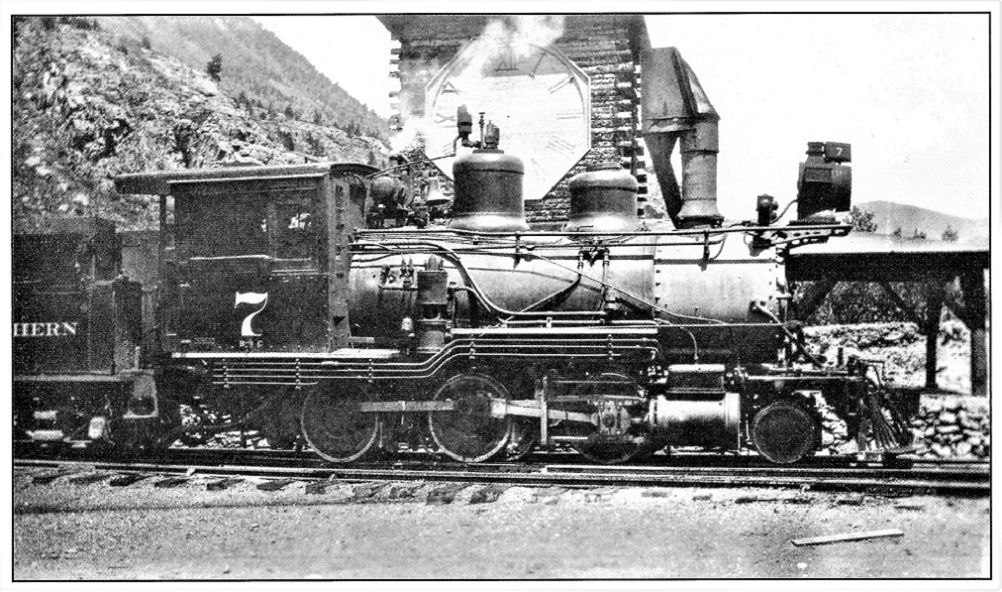 Dated to 1919. John Halliman Collection. While the rear of the tender is out of frame, the union of the larger diameter pipe or conduit is vaguely visible just above the retainer valve at the front edge of the coal side extensions. The photo of latest date that I've found are the Brownie Anderson wreck photos of C&S number 7 in March of 1928, after the runaway derailment at Peabodys:  Although bent, the A-frame and soup can are still attached to the locomotive. I'm going back and looking through the Denver Water Board Special photos of January, 1929. Although less than a year later, I don't recall any of the locomotives having this feature. The A-frame bracket with "light" seems to just up and disappear by the end of 1928. Wonder where and why they went? Alex: I've never noticed that baggage car 4 had a conduit running down the middle of the roof before! And I've never read about the C&S passenger equipment having electric interior lights installed, as the D&RGW did in the late 1930's. But both the soup can on the tenders and the union at the end of the baggage car conduit do seem to be made for each other. I can imagine something like the MU sockets on modern diesels. All you need is a a cable with plugs on each end to connect them. But the photo of baggage 4 with roof conduit is dated 1932, long after the brackets and soup cans disappeared from the locomotive tenders. Maybe Ken Martin can further clear up the purpose of the conduit on the baggage car.
Jim Courtney
Poulsbo, WA |
Re: 1920's ThingamoBob on Cooke 2-6-0 Tenders
|
The near exact match between the tender soup cans and the RPO soup can must mean something. It’s hard to believe that’s just coincidence….
Even before that, though, I was having trouble with the backup light theory. It just doesn’t seem like it's big enough for 1920s tech. |
Re: 1920's ThingamoBob on Cooke 2-6-0 Tenders
|
Well, it looks like C&S number 4 also was equipped with both the A-frame thingy and the wrap around conduit:
 Ed and Nancy Bathke collection, in the Klingers' South Park's Gunnison Division Memories . . . C&S number 4 is running helper to a stock extra at Garos in the early 1920's. Note the "intermediate" tender. The plug or socket on the end of the conduit is clearly visible near the gangway of the cab. But by 1929, number 4's tender has been rebuilt to it's modern configuration, and the A-frame, soup can and conduit are gone: http://digital.denverlibrary.org/cdm/singleitem/collection/p15330coll22/id/42092/rec/35  So, that is 6 out of 7 of the big Cooke 2-6-0's equipped with this odd contraption in the 1920's. If we can find a similar photo of number 6 so equipped, we can conclude that this bracket, soup can and conduit were standard equipment on the B-3-C class locomotives. Like Jeff, I'm still having trouble with the soup can being a back-up light, due to its size. An automotive headlamp could easily be mounted atop the bracket. I think we all agree that the tender side conduit and the soup can are electrical components. It could be a small rear marker I suppose, but I can't imagine its purpose. While mounted high, the soup can/mount is still shorter than the roof of any following passenger car, so couldn't be seen from the rear of the train. These engines seldom ran light. Was the purpose to reassure the conductor, on the last coach, that the locomotive was still at the front of the train? And if the soup can is an electrical receptacle, for a cable between locomotive and following baggage car or RPO, then what was electrically powered in the passenger consist? The RPO's, when rebuilt with a standard postal compartment in the 'teens, had overhead oil lamps, hence the vents visible on the top of the roof. Was there a postal regulation in the 1920's requiring electric lighting in railroad postal compartments?? If so, why was it relaxed in the late 1920's. Looks like this is just another oddity to be consigned to the C&S "X-Files".
Jim Courtney
Poulsbo, WA |
Re: 1920's ThingamoBob on Cooke 2-6-0 Tenders -- Baggage 4
|
This post was updated on .
In reply to this post by Alex Hois
Curios-er and curios-er . . .
I've looked through all my C&S passenger car photos. The only passenger car with roof conduit, or any visible connection for electrical power is C&S baggage 4. None of the other baggage cars, nor RPO's, nor RPO-coaches had any visible end connection to accommodate electrical cables. The earliest photos of baggage 4 with roof conduit are Jackson and Perry photos from 1929, after the A-frame/soup can/conduits had been removed from the Cooke 2-6-0 tenders: http://digital.denverlibrary.org/cdm/fullbrowser/collection/p15330coll22/id/42442/rv/singleitem/rec/2  And that box slung underneath baggage 4's floor looks too big to be a tool box -- is it a battery? If so, what for? What was inside baggage 4 that consumed electricity? None of this makes sense -- why outfit 6 or 7 locomotives with A-frame electrical connectors, to allow electrical connection from the locomotive's generator to a single head end car, that doesn't have obvious connections to other passenger cars?  UNLESS:  I've always considered these to be small holes with grommet, to allow a signal cord to pass from car to car. They are visible on the platform-less ends of the baggage cars 1-2-3 and the RPO's and RPO-coaches. Their location, just above the end doors, lines up in height with the A-frame/soup cans, as on the tender of C&S number 9 and baggage car 3: http://digital.denverlibrary.org/cdm/singleitem/collection/p15330coll22/id/42471/rec/1  Could this in fact be a recessed electrical plug, analogous to plugging in a phone charger into the cigarette lighter of your car?? If so, as Alex suggests, this would allow power from the locomotive generator to be transferred back to the RPO compartment, not necessarily to the passenger cars behind. We need your expertise here, Ken Martin! Did the C&S RPO compartments ever have electrical lighting??
Jim Courtney
Poulsbo, WA |
Re: 1920's ThingamoBob on Cooke 2-6-0 Tenders -- Baggage 4
|
Administrator
|
This post was updated on .
We're making this way too complicated. Using the principle of Occam's razor, this is probably just a simple a way to run the signal cord around the coal bunker. That would explain the oversized diameter of the conduit on the side sheet. The cord would need the larger diameter.
Probably used due to a high number of flag stops along the line. It probably didn't work too well, or wasn't needed after passenger service was discontinued on the Clear Creek Branch. It's anybody's guess why that conduit was on Baggage #4. |
Re: 1920's ThingamoBob on Cooke 2-6-0 Tenders -- Baggage 4
|
This post was updated on .
So you're saying that the "conduit" on the side of the tender coal board extensions is actually a hollow tube? The signal cord traveled from the forward most head end car to the A-frame with soup can, thence down and around the tender coal boards, to the tender gang way? And rang a bell or blew a whistle or something?
Hmmm . . . explains most everything but the "conduit" on the roof of baggage car 4 -- unless it was a hollow tube as well, with signal cord running above the roof of that car, rather than inside the clerestory. The little funnel at the end of the baggage "conduit" and the "soup can" on the tender A-frame would be small housings for the fasteners on the ends of the respective signal cord segments, both likely having a stop, to avoid getting lost in the hollow tubing. Best explanation yet. Occam was a smart fellow. 
Jim Courtney
Poulsbo, WA |
Re: 1920's ThingamoBob on Cooke 2-6-0 Tenders -- Baggage 4
|
Administrator
|
Yeah, he was, for sure.
It's very possible that they may have tried running the signal cord over the top of Baggage #4's roof as an experiment. It does have the hole in the usual place in the end wall, though. Probably wasn't worth the trouble. The box under the body is still a mystery, though. Hopefully, Ken will chime in with his thoughts, as our professor emeritus of passenger equipment. I'm at a loss to wonder what the method was to alert the engine crew to stop. The cord probably went through the rear of the cab wall, and could have triggered a buzzer or light (?) in the cab. I remember as a kid the signal cord in C&S coaches on the Denver/Billings passenger train through Boulder. My Dad told me what it was, I never knew how it worked, and I also never knew if it was still used. The coaches on that train were old 1918 (?) vintage steel cars that had been painted silver, I guess to "modernize" them so they looked up to date while sitting with the Zephyrs at Union station. All the mail cars were still painted green. One of them is now at the CRRM. I believe that train, #29/30, was discontinued in 1966 or '67. Pretty big stuff to ride, often free, from Boulder to Union station, from which an old school friend and I would wander up 17th St, with a detour to Caboose Hobbies, and then catch the bus back to Boulder. We were 15 and 16 when we did that. Can that really be 53 years ago? Holy cow, 53 years before 1965 was 1912! Sam Speas told us he would let us ride the cab on one trip. Unfortunately, on the appointed day, they had a C&S "Brass Hat" aboard, and we even had to pay to ride the coach. Dang. A cab ride with old Sam to Denver might have changed the course of my life. |
Re: 1920's ThingamoBob on Cooke 2-6-0 Tenders -- Baggage 4
|
In reply to this post by Jim Courtney
I was thinking about this today, while shoveling snow off a roof ...
... came to a similar conclusion/question. The idea of a belled-opening ferrule, through which passed a pull cord, the cord being pulled from different angles, based on a moving "other end" is quite similar to a number of steam era contraptions I have collected/restored. These often employ chain, as well as rope/cords. The belled opening made for smooth gliding entry, no matter the angle of the pull.
"Duty above all else except Honor"
|
Re: 1920's ThingamoBob on Cooke 2-6-0 Tenders -- Baggage 4
|
A cab ride with old Sam .....
You know, Mike .... I lived 1500 miles away and never knew any of them, but the ghosts that haunted the old mainline west of Garos called to me as we drove from Buena Vista to Fairplay, 39 years after the South Park line was scrapped. Been messed up ever since. You, Sir, were doomed to a life eccentricity and nostalgic ache ! 👍
"Duty above all else except Honor"
|
Re: 1920's ThingamoBob on Cooke 2-6-0 Tenders -- Baggage 4
|
Administrator
|
Yeah, SP, that's true. but I've had a very long and rewarding railroad career, albeit in miniature. And, I have been blessed to have known, in large part through my Dad's associations, several old C&S railroaders when I was growing up. Along the way, I have made many valuable friendships including with many of you here. I wouldn't change any of that for the world. Besides, if I had determined that I was "Goin' Railroading", or to pursue life as a full time musician in 1968, I might have been killed in Viet Nam as a friend was in 1970. As you would say, "Duty above all else except Honor".
Things usually work out the way they are supposed to, I guess. |
Re: 1920's ThingamoBob on Cooke 2-6-0 Tenders -- Baggage 4
|
Administrator
|
In reply to this post by Mike Trent
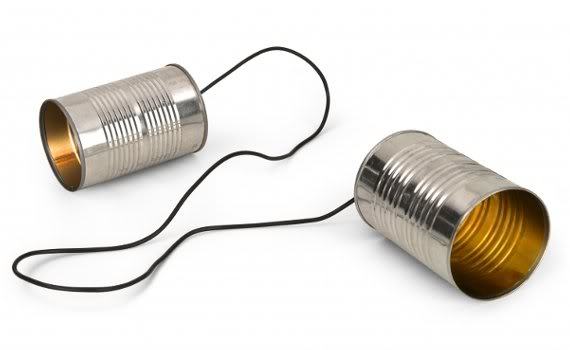
|
Re: 1920's ThingamoBob on Cooke 2-6-0 Tenders -- Baggage 4
|
Administrator
|

|
Re: 1920's ThingamoBob on Cooke 2-6-0 Tenders -- Baggage 4
|
In reply to this post by Jim Courtney
We need your expertise here, Ken Martin!
Did the C&S RPO compartments ever have electrical lighting?? Jim, I am afraid I can't be of much help here. I never noticed the conduit on #4 until mentioned here. I am not aware electrical lighting being installed but suppose it is possible. Now the only thing to check is #13 although it has been "restored". Ken Martin |
Re: 1920's ThingamoBob on Cooke 2-6-0 Tenders -- Baggage 4
|
Administrator
|
Ken, any idea why that rather substantial box may have been under the carbody of #4? It is behind the truss rod and doesn't seem to have a door which could be used to get heavy stuff in or out.
I've never seen any evidence of electrical lighting in any of the C&S narrow gauge passenger cars other than #911. #911 has conduit between both ends over the platforms, and as I recall, over the partition between the dinette area and WC. Power for those small lights was probably by battery. I'm sure the narrow gauge mail cars and coaches had no electrical. Electrical for the D&RGW's "San Juan" was provided by a large gas or diesel generator in the baggage car. The small locomotive generators had power only for the headlight (or, occasional backup light if only one was used at a time) and three or four small cab lights. I don't feel bad anymore about not noticing stuff that has come up in this thread since you hadn't either! |
«
Return to C&Sng Discussion Forum
|
1 view|%1 views
| Free forum by Nabble | Edit this page |

